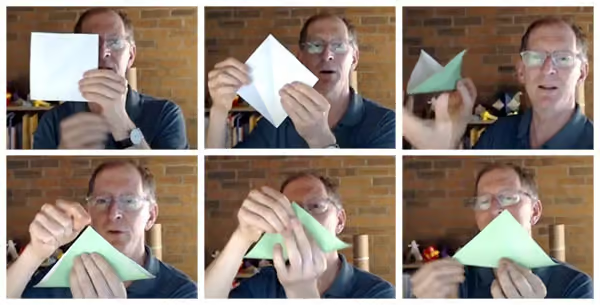Did you know…? You don’t need to be an expert to teach Origami!
Even if you are just beginning with origami, as soon as you learn something new you can turn around and teach it to someone. The act of teaching a simple origami model provides a great benefit for you as a teacher and for the learner.
Benefits of origami for the teacher
- It brings personal satisfaction by delivering joy and smiles to other people.
- It is a chance to share the magical transformation of paper into a recognizable figure.
- It solidifies our understanding of origami “When one teaches, two learn”
Benefits of origami for the learner
- It brings the satisfaction of solving a puzzle.
- It is a way to get trained to pay close attention and be mindful of details.
- It is an aesthetic experience.
- It is relaxing and entertaining.
- It encourages social interaction.
The realization that you do not have to be a folder of complex figures to teach origami prompted my friend Cliff Landesman to volunteer as an origami teacher in hospitals and senior centers.
Cliff was one of our recent guests in Origamigos, the Origami Spirit membership (recording available). We had the opportunity to hear his creative tips for teaching origami to first-time learners, his favorite audience.
By teaching as a volunteer, he has developed expertise and a framework to teach the art of origami.
His framework to teach origami includes approaching paper folding as a form of movement, “Origami –A Dance class for your fingers“. He usually begins by having people perform easy hand exercises as a warm-up and as a way to check students’ visual acuity.
Since he teaches people with physical or cognitive impairments, he is aware that forming a simple crease (a valley fold, for example) is a complex human ability.
Considering that, Cliff has identified basic hand movements we can keep in mind to make our teaching clearer.
What are the basic movements of origami?
According to Cliff, basic movements are not the same as basic folds, as we understand these terms.
These basic movements are different from the basic folds we are used to seeing at the beginning of origami books (the valley fold, the mountain fold, the reverse fold, the squash fold, the petal fold, the swivel fold, and the sink)
Cliff describes six elements of movement in origami. These are neither purely transformations of the paper (as are the Huzita-Justin Axioms) nor purely movements of the hands (as are hand gestures in classical Indian dance moves).
These building blocks are formulated as interactions between the hands and paper. Cliff proposes the following set of six movements: 1. holding 2. orienting 3. bending 4. aligning 5.pressing 6.sliding

In addition to describing these movements, in our interview (recording available in Origamigos), Cliff shared with us other tips to teach origami such as using simple models –He taught us a delightful and super simple model he designed, how to use storytelling, how to practice guided breathing, and exercises with thumb folding.
Ready to join a network for mentoring origami volunteers?
Cliff Landesman is building a group of people who are interested in either teaching origami or learning from a mentor. If you would like information on how to find a mentor or if you have some teaching experience and would like to be a mentor, please contact Cliff via email at cliff.landesman@gmail.com.
Do you have a question about teaching or learning origami?
Share it with us here as a comment. Also, if you have a helpful tip on how to teach origami we invite you to leave it as a comment as well.



